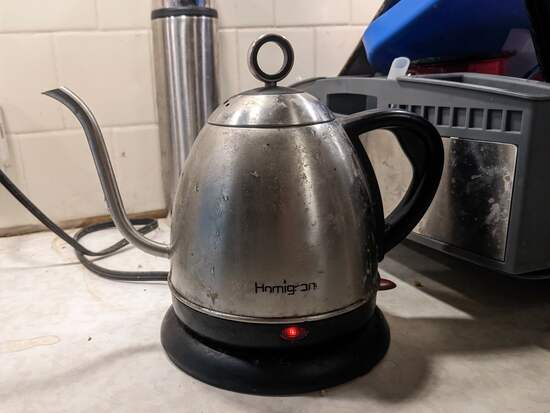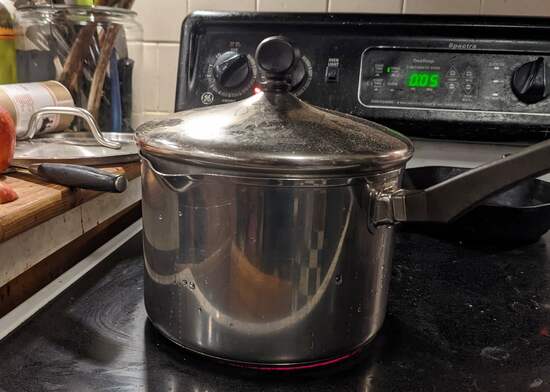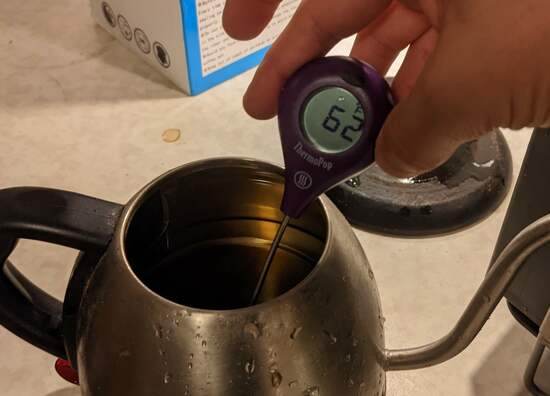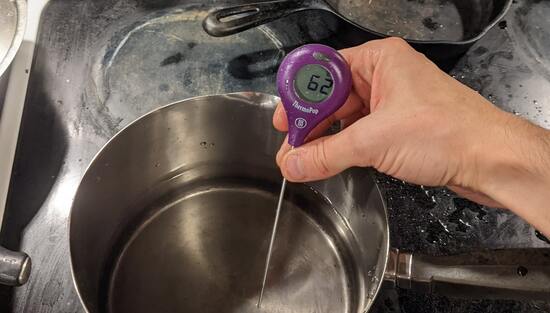Electric Kettle vs Stove
post by jefftk (jkaufman) · 2022-10-29T12:50:04.377Z · LW · GW · 7 commentsContents
7 comments
There was a discussion at lunch yesterday: what's faster to boil water, an (American) electric kettle or a pot on the stove? The kettle is more efficient but plugs into a 120V 15A receptacle on a shared circuit, while the stove has to transfer heat to a pot but gets exclusive use of a 240V 50A circuit (though not all of that goes into a single burner). I thought the stove, a coworker thought the kettle. Let's find out!
The contestants:
A Homigrand electric kettle, rated as drawing 1000W.
A Faberware stainless steel pot on a GE Spectra glass-top resistive electric stove (JBP66BBWH). The 6" burner I used is rated as drawing 1500W.
I filled them both with a quart (about a liter) of water, which was near the capacity of the kettle, and verified that both were starting at the same temperature (62F):
The thermometer is wet in the second picture because I accidentally dropped it into the pot, but it's rated IP66 and didn't mind.
I started them simultaneously, and waited. The kettle took 6:32 to reach its automatic shutoff, and I measured at at 212F. The pot took 7:20 until I guessed it was boiling from the sound, and it also measured 212F. So the pot is about 12% slower despite using 50% more power, so 68% more energy. Still, it's only 0.18kWh vs 0.11kWh which at $0.21/kWh is $0.04 vs $0.02 so I'm more interested in the time difference. Even that is small enough, however, that if what I want is boiling water in a pot to cook something I think I'll still use the pot.
One exception, which I was already doing, is that when I'm making pasta in a hurry, typically for the kids, I'll put half the water in each and then pour the kettle into the pot when it boils. (If I had been dividing the water exactly I'd have already known the answer to this question!) The main gains here are from parallelism, however, not efficiency.
This does make me wonder whether Americans (or British expats) ever put dedicated 240V outlets in their kitchens so they can use ~2-3x more powerful European kettles?
7 comments
Comments sorted by top scores.
comment by samgalam · 2022-10-30T12:05:14.546Z · LW(p) · GW(p)
Three other advantages of the electric kettle:
1. For those of us with gas stoves, we can skip the unhealthy step of burning something in our kitchen
2. The electric kettle has an automatic shutoff, which makes it a bit safer to forget about if leaving the room
3. More of the energy is going into heating the water, which means less heat goes into the room itself (don't care in winter, but I do in summer)
comment by Gunnar_Zarncke · 2022-10-29T13:50:56.918Z · LW(p) · GW(p)
Our European water kettle is rated 1700W (this one looks close), and I'm doing what you recommend when cooking soup or pasta, etc.: I put some water into the pot (often a big 5 liter one) and fill the electric kettle; once the latter cooks I pour it into the pot. Nice to hear that this actually saves energy.
To teach the kids the cost of electricity, I have put small stickers with the cost of the cooker, oven, and fridge. For example, the sticker on the fridge says: Short opening 1ct, not closing properly: 1€.
comment by gwillen · 2022-10-29T20:14:31.078Z · LW(p) · GW(p)
I'm surprised your kettle is only 1000W. You should be able to find a 1500W one. (The max power possible on a 15A circuit is higher, but I believe 1500W is the maximum permitted "continuous" power draw, and seems to be the typical maximum for heating appliances.)
As you say, if the circuit is shared, you may not be able to draw the max, but kitchen counter circuits are required to be separate from the rest of the house, so if you're not running other 120V kitchen appliances at the same time, you should have the full power of the circuit.
comment by jefftk (jkaufman) · 2022-10-29T18:36:03.331Z · LW(p) · GW(p)
Tested the microwave too -- 11:27.
Our microwave draws 1800W and puts out 1000W.
comment by Ericf · 2022-10-29T14:07:38.293Z · LW(p) · GW(p)
Depending on what kind of pasta dish is being made you can also:
- Use hot (120°F) water from the tap instead of cold.
- Use the Alton Brown method, where you put the pasta in the pot first, then add just enough water to cover (plus a little extra, like you would for rice), and heat from cold, stirring to keep the pasta from sticking. This reduces the total time from start to "pasta done", and you don't drain off the starchy water, so you get a creamier sauce (I use this regularly for Kraft Mac&Cheese) 2.5. Do that partially, where you still use a bunch of water, but add your pasta when it's half way to boiling. In either case, the pasta will be done cooking when the water boils (or like 1 minute after)
- Use a pressure cooker. It takes longer to boil, less time to cook, and you include your sauce with the pasta, so it's just one thing to clean
- Put the pasta in the kettle (before turning it on)
- Start the water boiling earlier, like when you start browning your meat (or vegan "meat") of making a quick sauce, to take the water boiling off the critical path.
- Use fresh pasta, which cooks in 2 minutes instead of 8
↑ comment by Stephen Bennett (GWS) · 2022-10-29T17:36:15.794Z · LW(p) · GW(p)
Does putting the pasta in the kettle gunk it up? They're a bit hard to clean and I wouldn't want starchy water in my tea.
Replies from: Ericf


